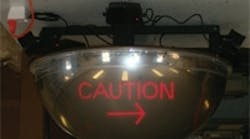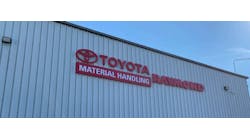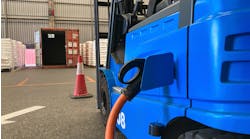Every three days, someone is killed in an accident involving a lift truck. That shocking statistic, courtesy of the National Institute for Occupational Safety and Health (NIOSH), adds fire to OSHA data. According to OSHA, 95,000 workers are injured, and approximately 100 are killed each year in accidents involving powered industrial trucks.
When you add litigation, fines, negative publicity and all the other costs of a fatal accident, the results are staggering. Lift truck safety guru David Hoover, president of Forklift Training Systems (Newark, Ohio), has served as an expert witness in court cases involving serious injuries and deaths related to lift truck accidents. “The cases I have worked in which there is a fatality almost always cost $1 million-plus to the customer,” he says.
Although OSHA’s requirement for educating operators of powered industrial trucks has helped to reduce accidents, it’s not a cure-all. Too many companies focus only on the bare essentials of operator education, and that’s not enough, according to Hoover.
Bill Chernick, president of Alert Safety Products (Cincinnati), agrees. “All education, until now, has been behavioral,” he says, meaning that many companies simply tell pedestrians and operators to be aware of potential dangers. Others try to keep people and lift trucks separate within a facility. Still, there’s no fail-safe way to prevent the deadly interaction that can occur between a pedestrian and a lift truck.
Fortunately, technologies that enhance behavioral education and provide that extra assurance of safety are readily available. Hoover says there are three types of pedestrian- safety technologies. “Some are lift truck-based,” he says. “Then, there are pedestrian-based systems, which include a device that pedestrians carry.” One example is the Pedestrian Alert Safety system from Copar Corp. (Burbank, Ill.). Pedestrians carry rechargeable, hand-held sender modules that interact with receiver sets mounted on lift trucks. Both alarms light up when a vehicle nears a pedestrian carrying the device. “The third system is site based, which protects a certain area, such as dangerous intersections,” Hoover says.
No matter how sophisticated, pedestrian-safety technologies have some drawbacks, according to Hoover. “People tend to tune out audible alarms, and some devices meant to be carried can be cumbersome. Sometimes, a facility will run out of devices, or the batteries will drain.” Hoover adds that site-based systems, such as ‘smart’ crosswalks that light up as people walk across, help protect pedestrians in the worst intersection but not at the second worst. “What if you have many intersections?” he asks. Even lift-truck-based safety systems have flaws. “Operators are only involved in a portion of actual fatalities,” he says. “These systems bring the driver’s attention to objects, not just humans. Lift trucks get near objects all the time, and something that screams at the operator constantly may drive him insane.”
The perfect solution has not yet been developed, says Hoover. “Some high-tech system that can sense the presence of a human, warn both parties, then take matters into its own hands would be tremendous.”
Nevertheless, there are technologies that take important steps toward protecting pedestrians. Following is a roundup of some of the latest.
More Than a Mirror
Alert Safety Products has transformed passive convex mirrors to active alarms with its dome mirror alerts. Available in 26-inch and 36-inch sizes, the mirrors are equipped with microwave units that detect the ferrous metal in moving objects within a range of 15 to 65 feet.
“There are circuit boards inside the mirror and microwave devices on the convex mirror,” says Chernick. “The microwaves pick up any type of vehicle. As something approaches an intersection, the mirror warns both pedestrians and drivers. People can see the visual alert from 50 or 60 feet away.”
Traffic Cop
The Speed Boss radar speed-control sign from RU2 Systems Inc. (Mesa, Ariz.) has its roots in law enforcement. The company has a 30% share of the highway traffic market, and within the past few years, it has ventured into warehouses, distribution centers and manufacturing facilities.
“The Speed Boss uses the same technology as radar signs on the road that alert speeders to how fast they are going,” says Ken Brown, vice president of sales and marketing at RU2 Systems. “We are borrowing technology that’s used in every city and applying it to a low-speed, industrial application,” he explains. “We were able to track a vehicle down to half a mile per hour, and that’s what broke us into the market.”
The Speed Boss features a vivid, 12-inch LED character that indicates the speed of a lift truck as it approaches. It serves as a public notice to pedestrians in the area as well as a declaration to the driver.
“A big percentage of lift truck accidents are speed related,” Brown says. “Drivers, motivated by production, will sometimes disable the onboard governor. Studies have shown that people will go the speed they are comfortable with, even when they are told otherwise. They don’t realize they are speeding. Speed happens.”
Safe Walkways
The Intersection Cross-traffic system from Bircher America Inc. (Elk Grove Village, Ill.) uses microwave sensors that detect vehicle traffic from up to 80 feet away. Typically installed over busy intersections and pedestrian crossings, the system alerts pedestrians when lift truck traffic is approaching. Once a lift truck is detected, audible and visual alarms are engaged until the vehicle passes through the intersection.
Door-Man Manufacturing Co. (Auburn Hills, Mich.) offers a similar technology: the Intersection Caution system. A microwave motion sensor detects vehicle traffic in the sensing area and engages visual and audible alarms.
Vehicle Detection
Sky-Trax Inc. (New Castle, Del.) offers two technologies for pedestrian safety. The company’s Fork Alert safety system uses beacons on vehicles and receivers in strategic positions throughout the facility to detect the presence of lift trucks in danger zones, providing pedestrians and drivers with at least four seconds to react. The infrared beams emitted from the vehicle beacons can trigger visual and audible alerts, locking gates or other safety devices.
The company’s Forklift Truck Safety system, which tracks real-time movement of lift trucks, can be used to illuminate crosswalk signals, audibly warn pedestrians or notify drivers of approaching hazards.



